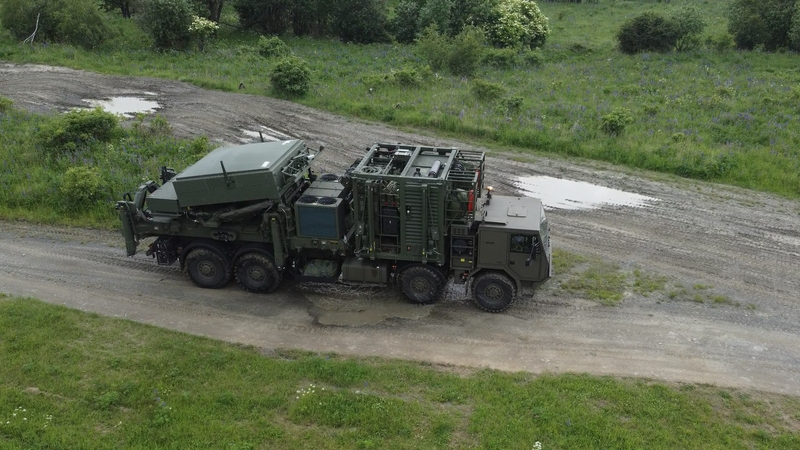Israeli MADR radar passes military tests, will expand the Air Defence capabilities of the Czech Armed Forces by the end of the year
Military trials of the MADR mobile 3D radar were successfully completed today. Critical deficiencies that have prolonged the military trials to this point were resolved on 17 April 2023. The contractor, Elta System Ltd, still has until the end of July to resolve the remaining minor defects, particularly in the area of documentation. However, these do not affect the combat capability of the system or its introduction into the armament of the Czech army. A total of eight MADR radars should be in use by the end of the year, with five sets currently in the Czech Republic.
According to Colonel Zdeněk Patera of the MoD's Force Development Section, who is the guarantor of the MADR 3D project, the last technical shortcomings of the radars that emerged during the military trials were successfully resolved this month. These included problems with the integration of the MADR into the national command and control system, failure to deliver complete technical, operational and safety documentation for the radar information system.
 Picture: Elta EL/M-2084 radar | Ministry of Defence of the Czech Republic
Picture: Elta EL/M-2084 radar | Ministry of Defence of the Czech Republic
"Elta System Ltd. undertook to eliminate all of these by 31 July 2023. However, these are not deficiencies that would negatively affect the introduction of the radars into the Czech army's arsenal," Colonel Zdeněk Patera confirmed, adding that the evaluation committee declared that the radar meets the requirements according to the specification and the intergovernmental agreement concluded between the Czech Republic and Israel on 5 December 2019.
The evaluation team will submit a report on the results of the military tests to the Chief of the General Staff of the Czech Armed Forces for signature on Monday. The takeover of the radars by the Army of the Czech Republic will begin on May 2 and they will subsequently be introduced into the armament of the 26th Command, Control and Reconnaissance Regiment. Five of the radars will be deployed at stationary military sites for the benefit of the NATO Integrated Air and Missile Defence System (NATINAMDS). The remaining three will be available for the protection of strategic targets and objects important for the defence of the state within the framework of the Czech Republic's National Standby Air Defence System (NaPoSy PVO ČR) and for the achievement of the Czech Armed Forces' commitments to NATO partners (Capability Targets).
"The road to modern radars for our army, which were first promised to it fourteen years ago, has been a long one. In the words of former Defence Minister Martin Stropnický, the project was ready "in ribbons" in 2017, but he did not want to sign it.... Unfortunately, he wasn't. Ungreasing took another seven years and I am the fourth MoD who had to deal with the project. We finally got it done and MADR has military trials. I am happy that the soldiers can finally start using the new radars," Defence Minister Jana Černochová said today.
The delivery of the MADR radars and their testing were accompanied by problems on all sides. When deliveries began in 2022, the Israeli manufacturer IAI and its Czech partners (VTÚ and Retia) had to solve major problems in integrating the radars into the 20-year-old control, command and reconnaissance systems of the Czech Armed Forces. The project itself was also delayed by bureaucracy.
The Czech Republic ordered a total of eight sets of the ELM-2084 MMR mobile 3D air defence radar from the Israeli company. The value of the order amounts to CZK 3.5 billion including VAT and has been verified and confirmed by an independent expert opinion. The Israeli radars are compatible with NATO systems and will replace in the arsenal the previously used but obsolete radar equipment of Russian origin. "It has already exceeded its life cycle several times and its parameters and capabilities are technologically incomparable to the newly acquired radars in terms of radar range, accuracy in detection and the ability to detect a wide range of targets from aircraft, UAVs to rocket and mortar munitions (C-RAM)," Patera added.
MADR will provide the Czech Army with an overview of the air situation at low and medium altitudes up to 3,000 m, i.e. in the area of national responsibility of the Czech Republic. It is one of the most advanced systems in existence and is part of the famous Iron Dome. In addition to the Israeli army, it is also used by other countries, such as Canada. Slovakia and Hungary are about to introduce the same type of radars into their armaments.
The EL/M-2084 multi-purpose radars will also be used to guide SPYDER missiles, with the Czech Army expected to receive a total of four batteries of this anti-aircraft missile system by 2026. Each of these batteries will include a radar, four launchers, a recharging vehicle and command and fire control systems. In order to take full advantage of the capabilities of the new radars in the SPYDER system, the Army still has the task of upgrading the software of the command and control systems.
However, the high-intensity conflict taking place just a few hundred kilometres from our territory suggests that the approach and numbers set so far, which were in line with the previous defence budget possibilities, are not sufficient. The air defence capability that will be acquired by the AFR after the full integration of MADRs and SPYDER will be able to deter isolated threats such as terrorist or accidental attacks of a very limited scale, but certainly not the long-term effects of a large number of hostile assets of various kinds.





















